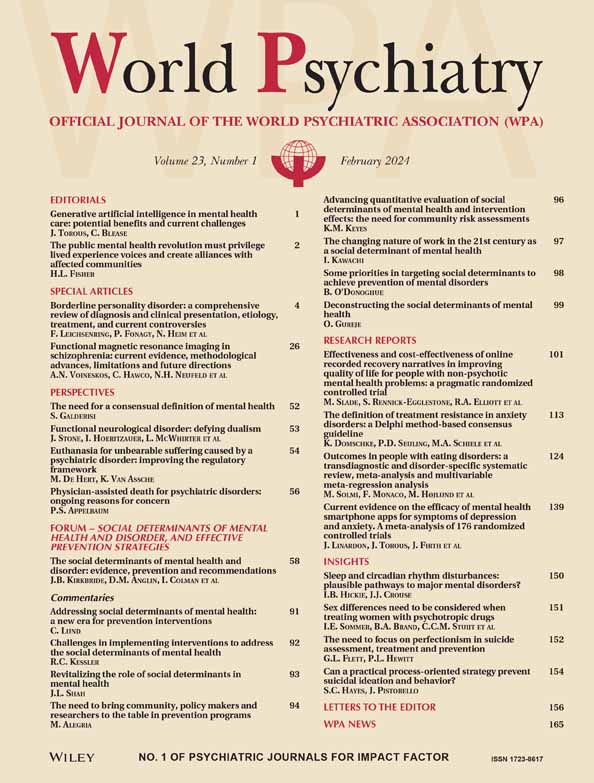年轻人和老年人的心血管风险和抑郁症发病率:来自SUN队列研究的证据
IF 65.8
1区 医学
Q1 PSYCHIATRY
引用次数: 18
摘要
ANCOVA分析,包括年龄和教育作为协变量。在排除非裔美国人(N515)的随访分析中,该模型仍然具有重要意义。5HTTLPR-S’等位基因携带者与L’等位基因纯合子个体相比,PTSD症状增加(IES平均评分:L’L 547.3 6 5.3, S559.8 6 4.1)。对于DISC1,与A携带者相比,T等位基因纯合的个体PTSD症状增加(A545.3 6 2.8, TT561.9 6 7.2)。在ANCOVA分析症状亚因素中,5-HTTLPR和DISC1选择性地影响侵入和超警觉症状,但不影响回避症状。每种风险基因型的PTSD症状严重程度(IES总分)平均增加40%(非538.4,一54.5,二565.6)。这些数据支持了先前关于5-HTTLPR对退伍军人PTSD症状影响的观察。尽管5-HTTLPR已被确定为平民人群中创伤后应激障碍易感性的潜在因素,但由于总体创伤暴露水平较低,它在这些人群中的作用可能不那么明显。5-HTTLPR对部署到战区的退伍军人创伤后应激障碍的影响可能更强,因为他们普遍和持续地暴露于威胁、军事训练和/或与家人和家庭社会支持分离。除了5-HTTLPR外,研究还发现,与多种精神障碍易感性相关的基因DISC1的遗传变异与PTSD症状的严重程度有关。同时拥有DISC1和5-HTTLPR风险基因型导致PTSD症状增加1.7倍。虽然这是DISC1 S704C TT等位基因作为PTSD危险因素的首次报道,但考虑到该等位基因已被确定为重度抑郁症的危险因素,这一发现并不令人惊讶。DISC1变异干扰一种对细胞器运输和线粒体拴系很重要的蛋白质复合物,干扰树突发育并降低额叶皮质树突棘的密度,这与我们最近报道的PTSD患者额叶皮质脊柱密度降低的情况相似。本研究旨在筛选对退伍军人创伤后应激障碍症状有较大影响的候选基因,这可能与影响平民人群创伤后应激障碍的一系列基因不同。研究创伤后应激障碍中的血清素系统在很大程度上是由血清素摄取抑制剂治疗创伤后应激障碍症状的治疗效用所推动的。我们的数据为该系统在PTSD药物治疗中的持续研究提供了额外的动力。此外,在动物模型中,利培酮等抗精神病药物已被证明可以逆转disc1相关的行为缺陷和病理生理,这表明这些药物可能会被重新研究作为创伤后应激障碍的替代药物疗法。Keith A. Young, Sandra B. Morissette, Robert Jamroz, Eric C. Meyer, Matthew S. Stanford, Li Wan, Nathan A. Kimbrel中央德州退伍军人医疗保健系统,坦普尔,德克萨斯州,美国;退伍军人事务部visn17退伍军人归国研究卓越中心,美国德克萨斯州韦科;美国德州坦普尔市德州农工大学健康科学中心精神病学与行为科学系;德克萨斯大学圣安东尼奥分校,美国德克萨斯州圣安东尼奥;希望与康复中心,休斯顿,德克萨斯州,美国;达勒姆退伍军人事务医疗中心,美国北卡罗来纳州达勒姆;VA中大西洋精神疾病研究、教育和临床中心,达勒姆,北卡罗来纳州,美国;杜克大学医学中心,美国北卡罗来纳州达勒姆本文章由计算机程序翻译,如有差异,请以英文原文为准。
Cardiovascular risk and incidence of depression in young and older adults: evidence from the SUN cohort study
ANCOVA analysis, which included age and education as covariates. The model also remained significant in a follow-up analysis in which participants who identified as AfricanAmerican (N515) were excluded. Carriers of the 5HTTLPR-S’ allele had increased PTSD symptoms compared to individuals homozygous for the L’ allele (IES mean score: L’L’547.3 6 5.3, S559.8 6 4.1). For DISC1, individuals homozygous for the T allele had increased PTSD symptoms compared to A carriers (A545.3 6 2.8, TT561.9 6 7.2). In ANCOVA analysis of symptom sub-factors, 5-HTTLPR and DISC1 selectively influenced intrusion and hypervigilance symptoms, but did not affect avoidance symptoms. PTSD symptom severity (total IES scores) increased by an average of 40% with each risk genotype (none538.4, one5 54.5, two565.6). These data support prior observations of 5-HTTLPR effects on PTSD symptoms in military veterans. Although 5-HTTLPR has been identified as a potential contributor to PTSD susceptibility in civilian-based populations, its effect may be less robust in those populations, due to lower overall level of trauma exposure. The effects of 5-HTTLPR on PTSD in military veterans after deployment to a war zone may be more robust because of a universal and constant exposure to threat, military training, and/or separation from family and home social support. In addition to 5-HTTLPR, genetic variation in DISC1, a gene associated with susceptibility to multiple mental disorders, was found to contribute to PTSD symptom severity. Possessing both DISC1 and 5-HTTLPR risk genotypes resulted in a 1.7fold increase in PTSD symptoms. Although this is the first report of DISC1 S704C TT allele as a risk factor for PTSD, the finding is not surprising, considering that this allele has been identified as a risk factor for major depression. DISC1 variants interfere with a protein complex important for organelle transport and in tethering of mitochondria, interfering with dendritic development and reducing densities of dendritic spines in the frontal cortex, paralleling our recent report of spine density reductions in the frontal cortex in PTSD. This study was powered to screen for candidate genes with relatively large effect sizes on PTSD symptoms in combat veterans, which may be different from sets of genes affecting PTSD in civilian populations. Study of the serotonin system in PTSD is motivated in large part by the therapeutic utility of serotonin uptake inhibitors to treat symptoms of PTSD. Our data provide additional impetus for continued study of this system in PTSD pharmacotherapy. In addition, antipsychotics such as risperidone have been shown to reverse DISC1-related behavioral deficits and pathophysiology in animal models, suggesting the possibility that such agents could be re-examined for use as alternative pharmacotherapies for PTSD. Keith A. Young, Sandra B. Morissette, Robert Jamroz, Eric C. Meyer, Matthew S. Stanford, Li Wan, Nathan A. Kimbrel Central Texas Veterans Health Care System, Temple, TX, USA; Department of Veterans Affairs VISN 17 Center of Excellence for Research on Returning War Veterans, Waco, TX, USA; Department of Psychiatry and Behavioral Science, Texas A&M Health Science Center, Temple, TX, USA; University of Texas at San Antonio, San Antonio, TX, USA; Hope and Healing Center & Institute, Houston, TX, USA; Durham Veterans Affairs Medical Center, Durham, NC, USA; VA Mid-Atlantic Mental Illness Research, Education, and Clinical Center, Durham, NC, USA; Duke University Medical Center, Durham, NC, USA
求助全文
通过发布文献求助,成功后即可免费获取论文全文。
去求助
来源期刊

World Psychiatry
医学-精神病学
自引率
7.40%
发文量
124
期刊介绍:
World Psychiatry is the official journal of the World Psychiatric Association. It is published in three issues per year.
The journal is sent free of charge to psychiatrists whose names and addresses are provided by WPA member societies and sections.
World Psychiatry is also freely accessible on Wiley Online Library and PubMed Central.
The main aim of World Psychiatry is to disseminate information on significant clinical, service, and research developments in the mental health field.
The journal aims to use a language that can be understood by the majority of mental health professionals worldwide.
 求助内容:
求助内容: 应助结果提醒方式:
应助结果提醒方式:


